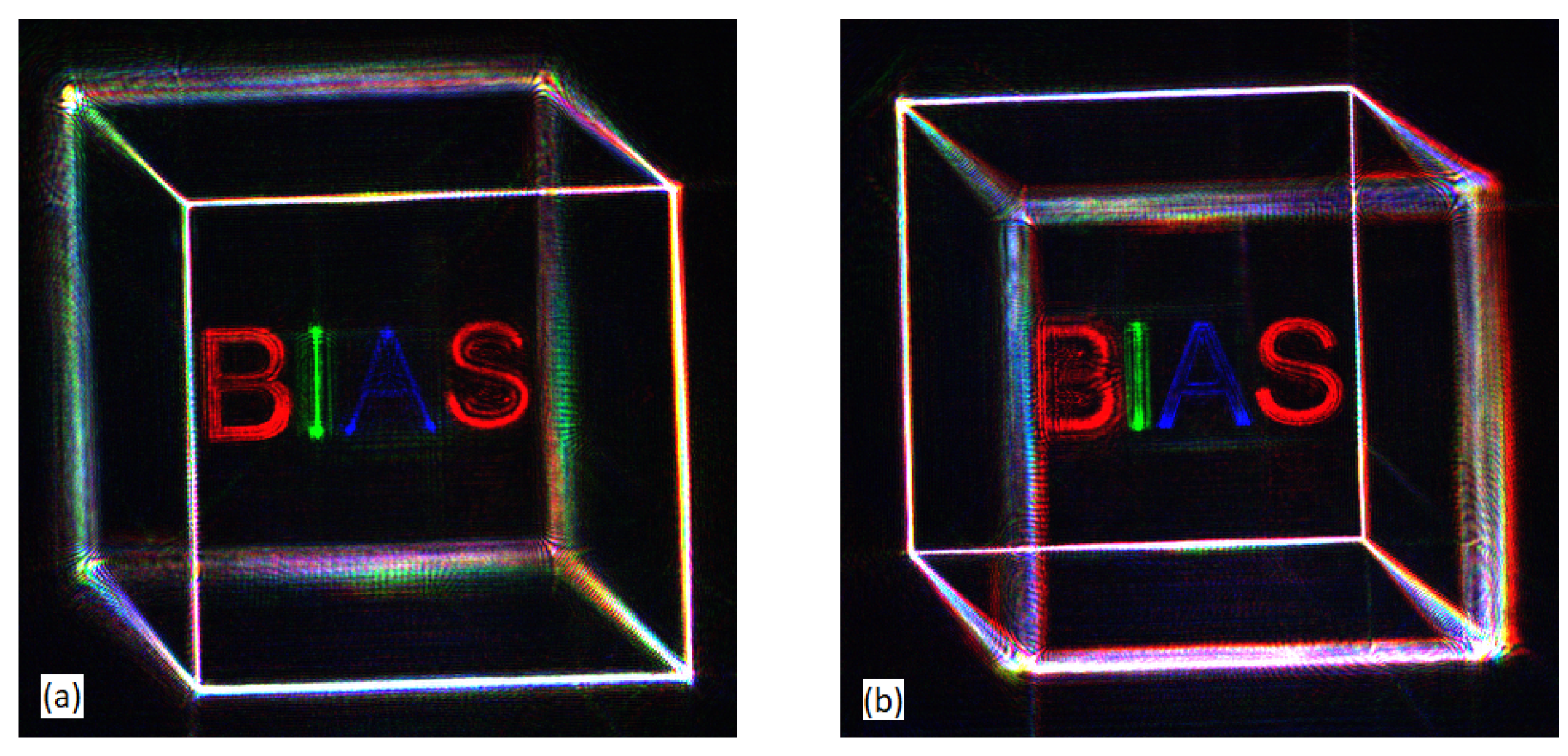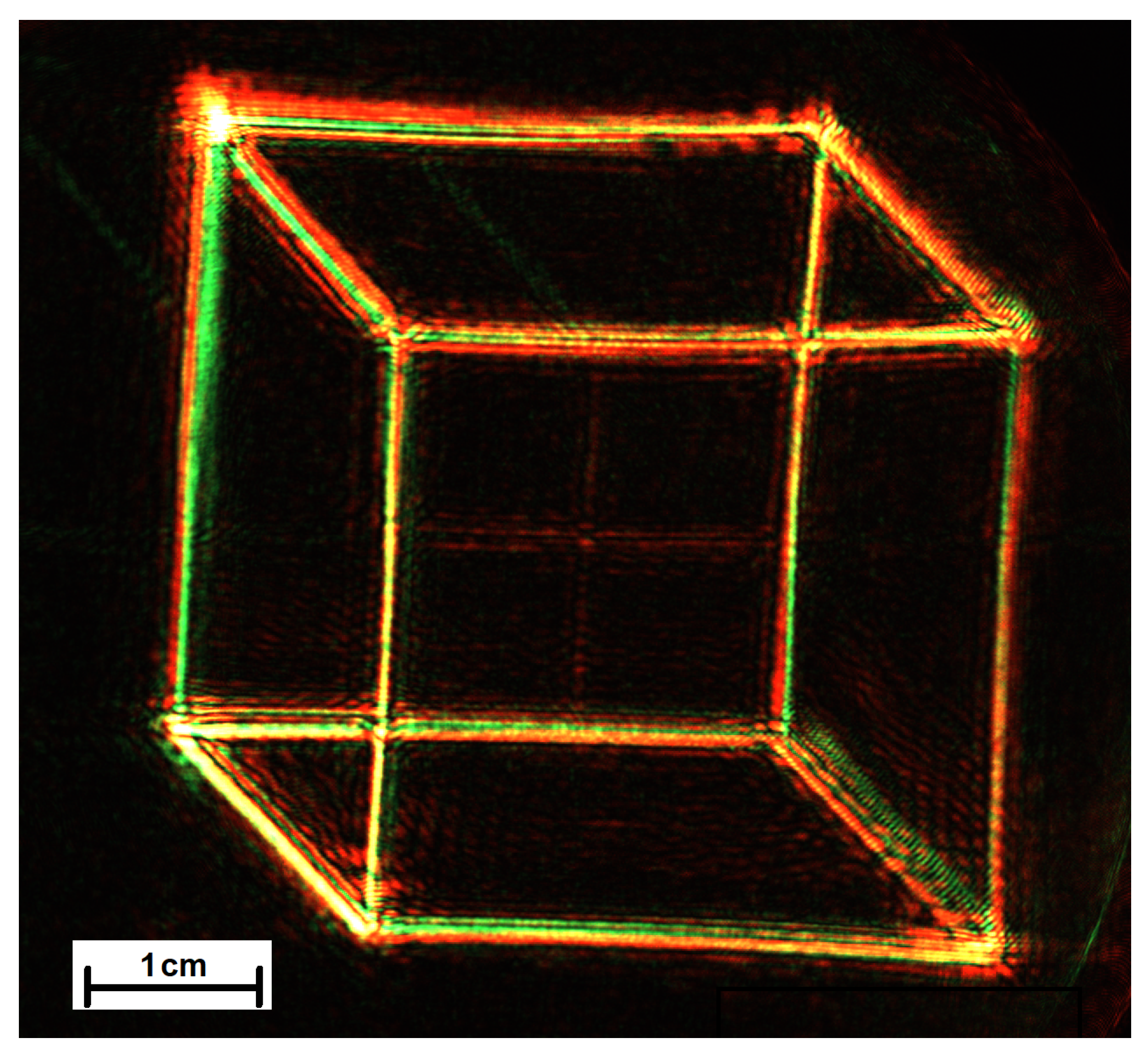Multicolor Holographic Display of 3D Scenes Using Referenceless Phase Holography (RELPH)
Abstract
:1. Introduction
2. Mathematical Description and Experimental Setup
2.1. Mathematical Description of RELPH
2.2. Setup of RELPH
2.3. Magnification of RELPH-Generated 3D Scenes
3. Experimental Results
3.1. Temporal Multiplexing
3.2. Spatial Multiplexing
4. Discussion
Author Contributions
Funding
Institutional Review Board Statement
Informed Consent Statement
Data Availability Statement
Acknowledgments
Conflicts of Interest
Abbreviations
| RELPH | Referenceless phase holography |
| SLM | Spatial light modulator |
| CCD | Charge-coupled device |
| SBP | space–bandwidth product |
| BS | beam-splitter |
References
- Caulfield, H.J.; Leith, E.N.; Denisyuk, Y.N. The Art and Science of Holography; Society of Photo-Optical Instrumentation Engineers (SPIE): Bellingham, WA, USA, 2003. [Google Scholar]
- Maimone, A.; Georgiou, A.; Kollin, J.S. Holographic near-eye displays for virtual and augmented reality. ACM Trans. Graph. 2017, 36, 1–16. [Google Scholar] [CrossRef]
- Agour, M.; Kreis, T. Experimental investigation of holographic 3D-TV approach. In Proceedings of the 2009 3DTV Conference: The True Vision-Capture, Transmission and Display of 3D Video, Potsdam, Germany, 4–6 May 2009; pp. 1–4. [Google Scholar]
- Smalley, D.; Nygaard, E.; Squire, K.; Van Wagoner, J.; Rasmussen, J.; Gneiting, S.; Qaderi, K.; Goodsell, J.; Rogers, W.; Lindsey, M.; et al. A photophoretic-trap volumetric display. Nature 2018, 553, 486–490. [Google Scholar] [CrossRef] [PubMed]
- Hirayama, R.; Plasencia, D.M.; Masuda, N.; Subramanian, S. A volumetric display for visual, tactile and audio presentation using acoustic trapping. Nature 2019, 575, 320–323. [Google Scholar] [CrossRef] [PubMed]
- Huang, F.C.; Luebke, D.P.; Wetzstein, G. The light field stereoscope. In SIGGRAPH Emerging Technologies; Association for Computing Machinery: Los Angeles, CA, USA, 2015; pp. 1–24. [Google Scholar]
- Hua, H.; Javidi, B. A 3D integral imaging optical see-through head-mounted display. Opt. Express 2014, 22, 13484–13491. [Google Scholar] [CrossRef] [PubMed]
- Hong, J.; Kim, Y.; Choi, H.J.; Hahn, J.; Park, J.H.; Kim, H.; Min, S.W.; Chen, N.; Lee, B. Three-dimensional display technologies of recent interest: Principles, status, and issues [Invited]. Appl. Opt. 2011, 50, H87–H115. [Google Scholar] [CrossRef] [PubMed] [Green Version]
- Kujawinska, M.; Kozacki, T.; Falldorf, C.; Meeser, T.; Hennelly, B.M.; Garbat, P.; Zaperty, W.; Niemelä, M.; Finke, G.; Kowiel, M.; et al. Multiwavefront digital holographic television. Opt. Express 2014, 22, 2324–2336. [Google Scholar] [CrossRef] [PubMed] [Green Version]
- Smalley, D.E.; Smithwick, Q.; Bove, V.; Barabas, J.; Jolly, S. Anisotropic leaky-mode modulator for holographic video displays. Nature 2013, 498, 313–317. [Google Scholar] [CrossRef]
- Slinger, C.; Cameron, C.; Stanley, M. Computer-generated holography as a generic display technology. Computer 2005, 38, 46–53. [Google Scholar] [CrossRef]
- Jia, J.; Chen, J.; Yao, J.; Chu, D. A scalable diffraction-based scanning 3D colour video display as demonstrated by using tiled gratings and a vertical diffuser. Sci. Rep. 2017, 7, 1–9. [Google Scholar]
- Agour, M.; Falldorf, C.; von Kopylow, C.; Bergmann, R.B. Speckle reduction in holographic projection using temporal-multiplexing of spatial frequencies. In Proceedings of the 2013 3DTV Vision Beyond Depth (3DTV-CON), Aberdeen, UK, 7–8 October 2013; pp. 1–4. [Google Scholar]
- Agour, M.; Falldorf, C.; Bergmann, R.B. Holographic display system for dynamic synthesis of 3D light fields with increased space bandwidth product. Opt. Express 2016, 24, 14393–14405. [Google Scholar] [CrossRef]
- Kamau, E.N.; Heine, J.; Falldorf, C.; Bergmann, R.B. Dynamic wave field synthesis: Enabling the generation of field distributions with a large space–bandwidth product. Opt. Express 2015, 23, 28920–28934. [Google Scholar] [CrossRef] [PubMed]
- Blanche, P.A.; Bablumian, A.; Voorakaranam, R.; Christenson, C.; Lin, W.; Gu, T.; Flores, D.; Wang, P.; Hsieh, W.Y.; Kathaperumal, M.; et al. Holographic three-dimensional telepresence using large-area photorefractive polymer. Nature 2010, 468, 80–83. [Google Scholar] [CrossRef] [PubMed]
- Reichelt, S.; Häussler, R.; Fütterer, G.; Leister, N. Depth cues in human visual perception and their realization in 3D displays. In Three-Dimensional Imaging, Visualization, and Display 2010 and Display Technologies and Applications for Defense, Security, and Avionics IV; International Society for Optics and Photonics (SPIE): Orlando, FL, USA, 2010; Volume 7690, p. 76900B. [Google Scholar]
- Haeussler, R.; Gritsai, Y.; Zschau, E.; Missbach, R.; Sahm, H.; Stock, M.; Stolle, H. Large real-time holographic 3D displays: Enabling components and results. Appl. Opt. 2017, 56, F45–F52. [Google Scholar] [CrossRef] [PubMed]
- Yang, X.; Song, P.; Zhang, H.; Wang, Q.H. Full-color computer-generated holographic near-eye display based on white light illumination. Opt. Express 2019, 27, 38236–38249. [Google Scholar] [CrossRef] [PubMed]
- Kozacki, T.; Chlipala, M. Color holographic display with white light LED source and single phase only SLM. Opt. Express 2016, 24, 2189–2199. [Google Scholar] [CrossRef]
- Kozacki, T.; Chlipala, M.; Makowski, P.L. Color Fourier orthoscopic holography with laser capture and an LED display. Opt. Express 2018, 26, 12144–12158. [Google Scholar] [CrossRef]
- Kazempourradi, S.; Ulusoy, E.; Urey, H. Full-color computational holographic near-eye display. J. Inf. Disp. 2019, 20, 45–59. [Google Scholar] [CrossRef]
- Wang, Y. Color dynamic holographic 3D displays: Approaches and systems. In Digital Holography and Three-Dimensional Imaging; Optical Society of America: JeJu Island, Korea, 2017. [Google Scholar]
- Shi, L.; Li, B.; Kim, C.; Kellnhofer, P.; Matusik, W. Towards real-time photorealistic 3D holography with deep neural networks. Nature 2021, 591, 234–239. [Google Scholar] [CrossRef] [PubMed]
- Choi, S.; Kim, J.; Peng, Y.; Wetzstein, G. Optimizing image quality for holographic near-eye displays with michelson holography. Optica 2021, 8, 143–146. [Google Scholar] [CrossRef]
- Shi, L.; Huang, F.C.; Lopes, W.; Matusik, W.; Luebke, D. Near-eye light field holographic rendering with spherical waves for wide field of view interactive 3d computer graphics. ACM Trans. Graph. 2017, 36, 1–17. [Google Scholar] [CrossRef]
- Kreis, T. 3-d display by referenceless phase holography. IEEE Trans. Ind. Inform. 2016, 12, 685–693. [Google Scholar] [CrossRef]
- Kreis, T. Referenceless Phase Holography for 3D Imaging. 3D Res. 2017, 8, 1–18. [Google Scholar] [CrossRef]
- Schnars, U.; Falldorf, C.; Watson, J.; Jüptner, W. Digital holography. In Digital Holography and Wavefront Sensing; Springer: Berlin/Heidelberg, Germany, 2015; pp. 39–68. [Google Scholar]
- Goodman, J.W. Introduction to Fourier Optics; Roberts and Company Publishers: Greenwood Village, CO, USA, 2005. [Google Scholar]
- Agour, M.; Falldorf, C.; Von Kopylow, C. Digital pre-filtering approach to improve optically reconstructed wavefields in opto-electronic holography. J. Opt. 2010, 12, 055401. [Google Scholar] [CrossRef]





Publisher’s Note: MDPI stays neutral with regard to jurisdictional claims in published maps and institutional affiliations. |
© 2021 by the authors. Licensee MDPI, Basel, Switzerland. This article is an open access article distributed under the terms and conditions of the Creative Commons Attribution (CC BY) license (https://creativecommons.org/licenses/by/4.0/).
Share and Cite
Müller, A.F.; Rukin, I.; Falldorf, C.; Bergmann, R.B. Multicolor Holographic Display of 3D Scenes Using Referenceless Phase Holography (RELPH). Photonics 2021, 8, 247. https://doi.org/10.3390/photonics8070247
Müller AF, Rukin I, Falldorf C, Bergmann RB. Multicolor Holographic Display of 3D Scenes Using Referenceless Phase Holography (RELPH). Photonics. 2021; 8(7):247. https://doi.org/10.3390/photonics8070247
Chicago/Turabian StyleMüller, André F., Ilja Rukin, Claas Falldorf, and Ralf B. Bergmann. 2021. "Multicolor Holographic Display of 3D Scenes Using Referenceless Phase Holography (RELPH)" Photonics 8, no. 7: 247. https://doi.org/10.3390/photonics8070247
APA StyleMüller, A. F., Rukin, I., Falldorf, C., & Bergmann, R. B. (2021). Multicolor Holographic Display of 3D Scenes Using Referenceless Phase Holography (RELPH). Photonics, 8(7), 247. https://doi.org/10.3390/photonics8070247




